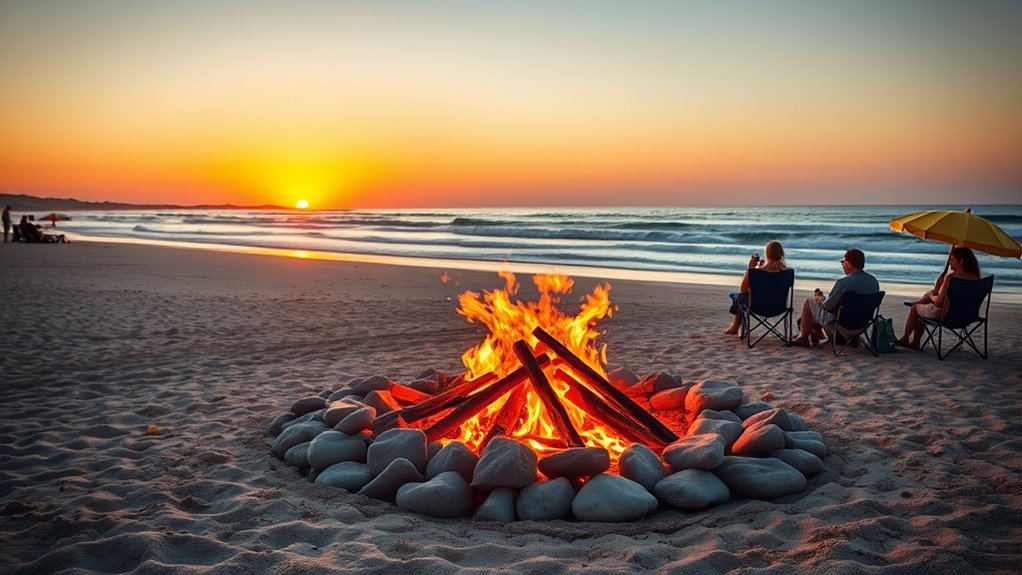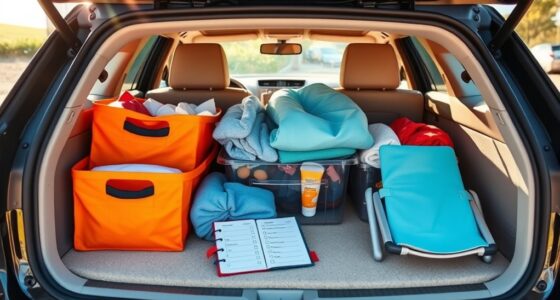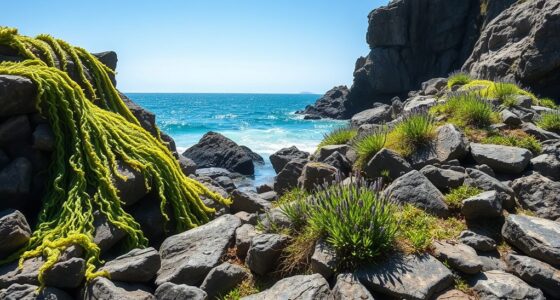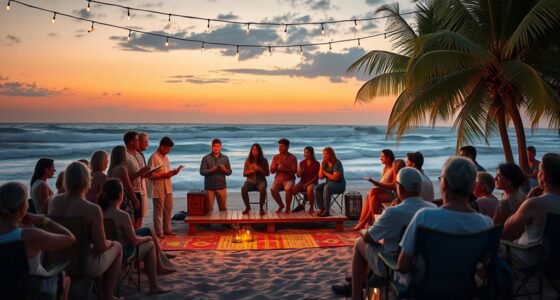To enjoy a safe bonfire on a public beach, start by checking local regulations and obtaining any necessary permits. Choose a flat, clear spot away from vegetation, structures, and overhead hazards. Prepare the area by clearing debris and creating a fire ring with rocks or digging a shallow pit. Keep the fire manageable, never leave it unattended, and fully extinguish it with water before leaving. To discover more about responsible beach bonfire practices, continue exploring expert advice.
Key Takeaways
- Check local regulations and obtain permits before starting a bonfire on the beach.
- Select a flat, clear area away from vegetation, structures, and overhead hazards.
- Create a fire ring with rocks or dig a shallow pit to contain the flames safely.
- Keep the fire manageable, never leave it unattended, and have water or fire extinguishing tools nearby.
- Fully extinguish the fire with water, stir ashes, and clean up debris to protect the environment.
Check Local Regulations and Permits
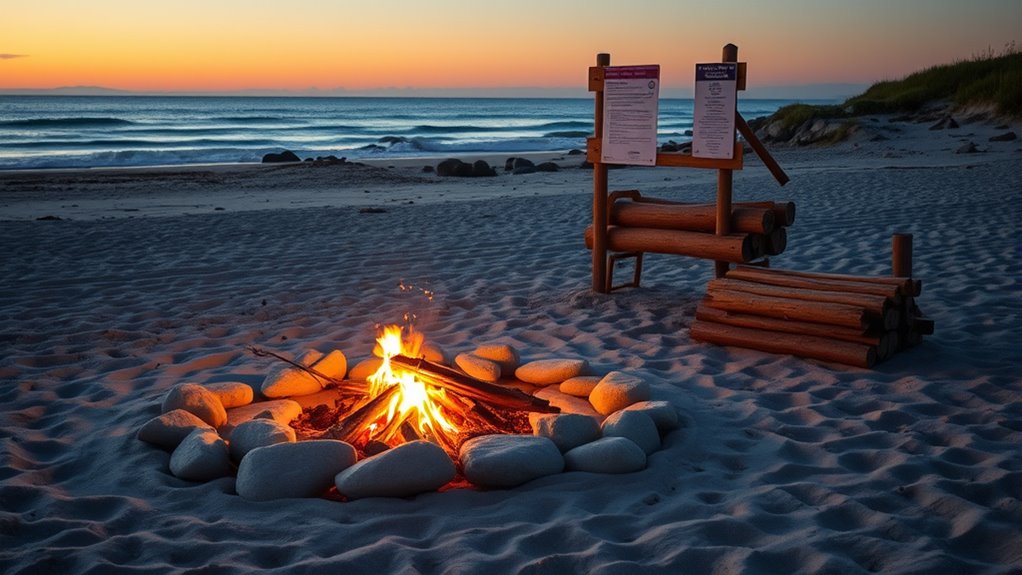
Before starting your bonfire, it’s essential to check local regulations and obtain any necessary permits. Different beaches have unique rules about fire safety, size limits, and designated areas. Failing to follow these rules can lead to fines or fire bans, especially during dry seasons. Visit your city or county website or contact local authorities to understand specific requirements. Some places require a permit even for small fires, while others prohibit open flames altogether. Make sure you are aware of the rules before you plan your gathering. Additionally, understanding fire safety regulations can prevent accidents and ensure a safe environment for everyone. Being aware of beach fire restrictions helps you avoid unintentional violations and penalties. Consulting local guidelines can also help you identify fire-resistant materials to use for your setup, reducing the risk of unintended fires. Checking local fire danger level can also inform your decision to proceed with a bonfire on a particular day. Staying informed about emergency procedures ensures you’re prepared in case of an incident. Taking these steps shows respect for local policies and helps keep everyone safe while enjoying your beach bonfire.
Choose a Safe and Appropriate Location
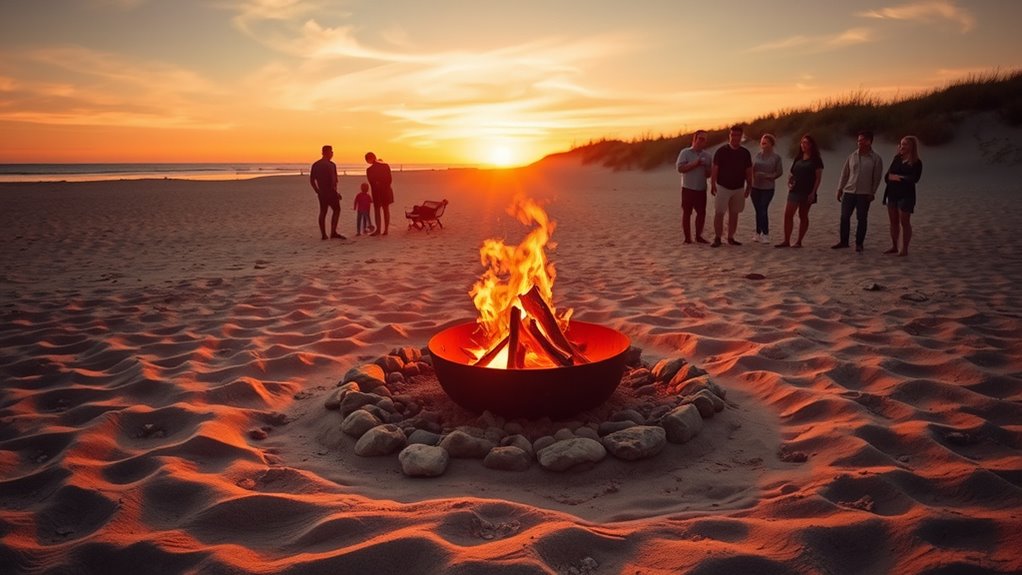
Selecting the right spot for your bonfire is essential to guarantee safety and prevent damage. Look for a clear, flat area away from dunes, vegetation, and structures. Avoid placing your fire near dry grass, driftwood, or other flammable materials that could easily catch fire. Make sure the spot is at least 15 feet from water, pathways, and any nearby tents or belongings. Check for overhead hazards like low-hanging branches or power lines. Choose a location that’s easily accessible for you and emergency responders if needed. Also, confirm the area isn’t designated as a protected zone or has restrictions. Picking a safe, open spot helps ensure everyone’s safety and keeps the environment protected during your beach bonfire. Be mindful of water parks and other nearby attractions that may have specific safety guidelines for outdoor activities. Always verify the local regulations to ensure your bonfire complies with safety and environmental standards. Monitoring local fire restrictions is also crucial, especially during dry seasons, to prevent unintended fires.
Prepare Your Bonfire Area Properly
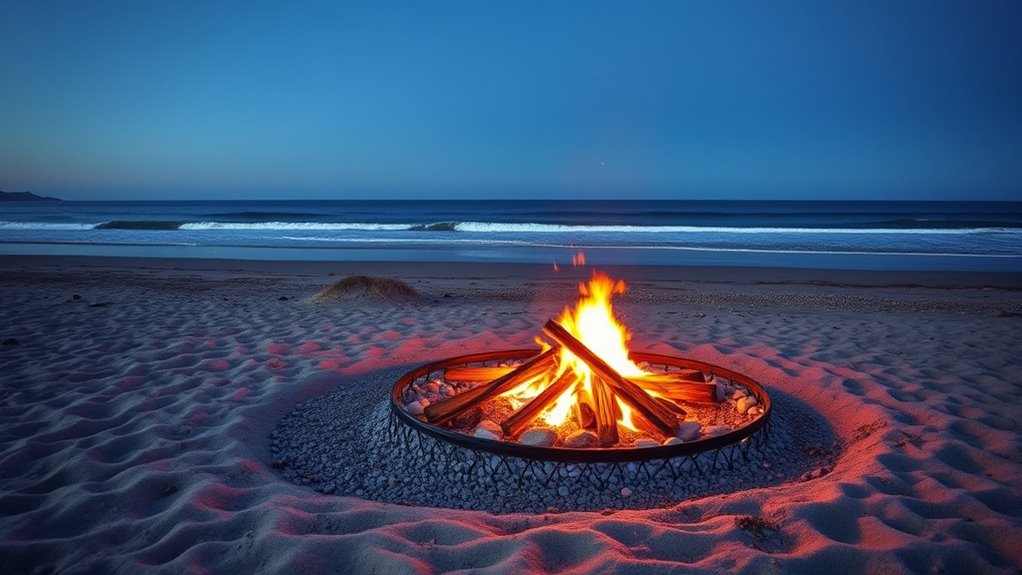
To guarantee a safe and manageable bonfire, you need to prepare the area properly. Clear the spot of any debris, leaves, or flammable materials that could catch fire accidentally. Dig a shallow pit or create a fire ring using rocks to contain the flames and prevent them from spreading. Keep the area around the fire clear of overhanging branches, tall grass, or anything else that could ignite easily. Make sure you have enough space to move safely around the fire and set up a safe zone to keep bystanders at a safe distance. Also, place a bucket of water, a hose, or a fire extinguisher nearby for quick access. Proper preparation helps control the fire and ensures everyone’s safety. Additionally, understanding fire safety protocols can significantly reduce the risk of accidents during bonfire activities. Regularly monitoring the fire and having a fire suppression method ready are essential for maintaining safety throughout the event. Being aware of emergency procedures can further aid in quick response if an incident occurs. Implementing safety guidelines and ensuring proper fire extinguisher maintenance can provide additional layers of protection and peace of mind.
Practice Safe Fire Management and Extinguishing Techniques
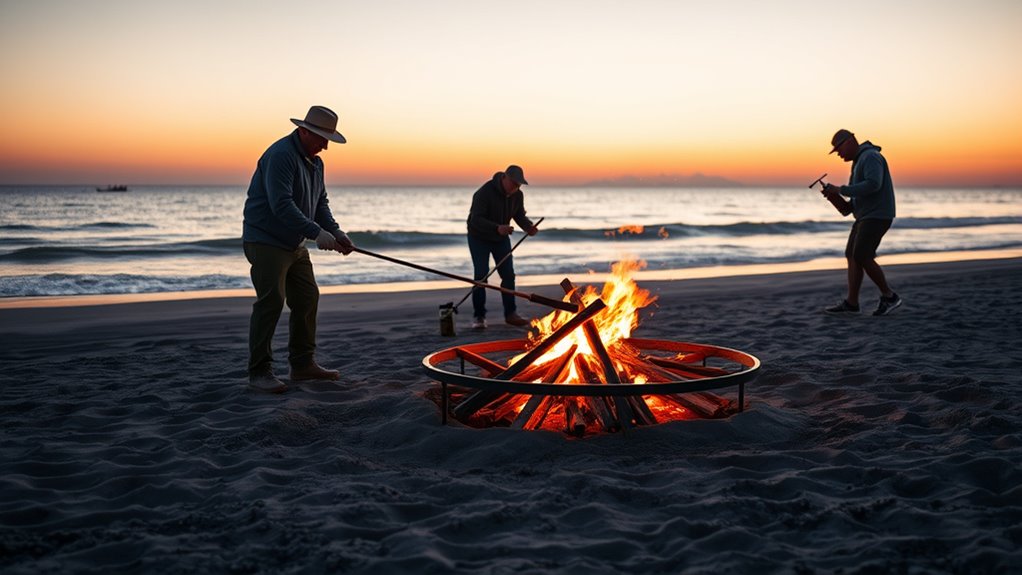
Practicing safe fire management and extinguishing techniques is essential to prevent accidents and guarantee everyone’s safety. Always keep your bonfire manageable; don’t stack too many logs or let the fire grow uncontrollably. Never leave the fire unattended, especially when it’s burning or still hot. Keep a bucket of water, a hose, or a fire extinguisher nearby, and know how to use them quickly if needed. When it’s time to extinguish the fire, pour water over the flames gradually, stirring the ashes to ensure everything is fully cooled. Confirm that the fire is completely out and cool to the touch before leaving the area. Proper management and extinguishing not only protect you but also prevent wildfires and keep the beach safe for everyone. Understanding fire safety measures can further help in ensuring responsible and safe bonfire practices. Regularly inspecting your fire area and practicing fire safety techniques helps reduce risk and promotes a safer environment for all beachgoers.
Respect the Environment and Other Beachgoers
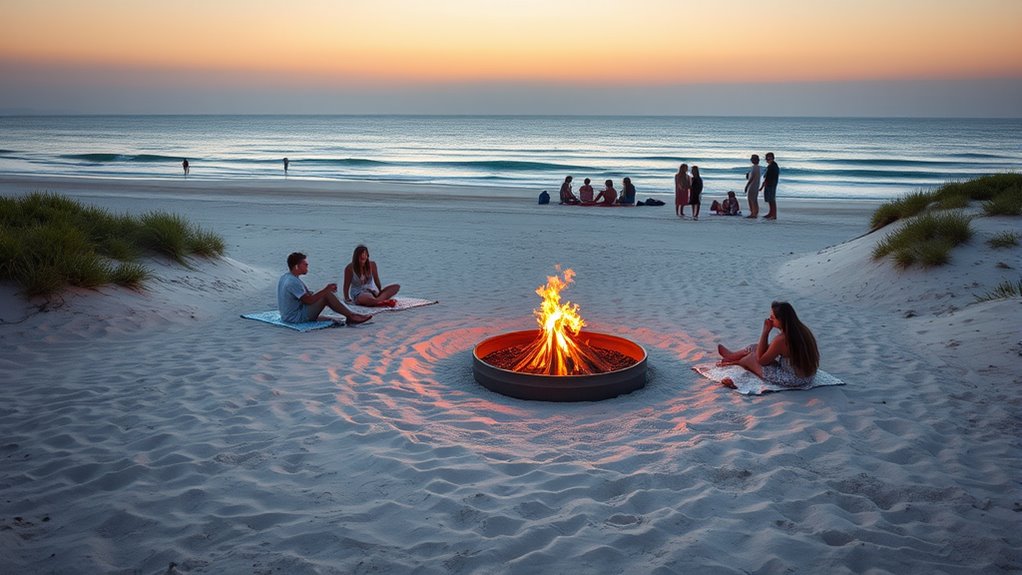
Respecting the environment and fellow beachgoers is essential when enjoying a bonfire. Always keep noise levels considerate, especially late at night, so you don’t disturb others. Use designated fire pits to prevent damage to the natural surroundings and avoid leaving trash behind. When you’re done, make sure the fire is fully extinguished and clean up all debris. Be mindful of wildlife; avoid disturbing nesting areas or habitats nearby. Respect the space of other beach visitors by giving everyone room to enjoy the area safely. Keep pets on a leash and clean up after them. Additionally, consider the importance of water safety when around aquatic environments to prevent accidents. Incorporate natural resource preservation practices by minimizing your impact on the environment and supporting sustainable beach activities. Being aware of weather patterns can also help you plan safer bonfire sessions, especially in areas prone to sudden weather changes. Staying informed about local regulations ensures you adhere to fire safety rules and avoid penalties. Recognizing environmental impact helps in making responsible choices that protect the beach ecosystem. By following these simple guidelines, you help preserve the beauty of the beach and ensure everyone has a safe, enjoyable experience.
Frequently Asked Questions
Can I Have a Bonfire on Any Public Beach Without Restrictions?
You can’t have a bonfire on any public beach without restrictions. Local regulations often limit or prohibit fires to protect the environment and public safety. Before you light up, check with local authorities or park services for specific rules, permits, and designated areas. Always follow posted signs and guidelines. Responsible bonfire practices help prevent accidents, injuries, and environmental damage, ensuring everyone can enjoy the beach safely and responsibly.
What Types of Materials Are Safe to Burn During a Beach Bonfire?
Like Icarus flying too close to the sun, you should be cautious when choosing materials for your beach bonfire. Stick to natural, untreated wood, like driftwood or logs, and avoid burning plastics, painted wood, or treated lumber. These materials release toxic fumes and can harm the environment. Always check local regulations, and remember, safety and respect for nature keep your bonfire enjoyable and eco-friendly.
How Can I Prevent Sparks or Embers From Spreading Beyond the Fire Pit?
To prevent sparks or embers from spreading beyond your fire pit, you should keep a water source or fire extinguisher nearby, and guarantee the area around your fire is clear of flammable debris. Use a sturdy, non-flammable barrier around your fire, and don’t add excessive wood all at once. Always stay attentive, and monitor the fire until it’s completely extinguished, so sparks don’t cause unintended fires.
Are There Specific Times of Day When Bonfires Are Prohibited?
Imagine you’re in a time before modern rules, yet now, you should know that bonfires are often prohibited during high winds or extreme weather, typically in the late afternoon or during fire bans. Check local regulations and weather conditions before lighting up. Authorities often restrict fires during dry seasons or when fire risk is high, so plan your beach visit accordingly to stay safe and avoid penalties.
What Should I Do if I Encounter Smoke or Fire-Related Emergencies?
If you encounter smoke or fire emergencies, first stay calm and assess the situation. If it’s a small fire, try to extinguish it with available resources like water or a fire extinguisher. For larger fires or if you’re unsure, immediately call emergency services and move to a safe distance. Alert others nearby and follow any posted safety instructions. Your quick, calm response can help prevent further danger.
Conclusion
By following these safe bonfire practices, you can enjoy your beachside evening responsibly, like a gentle breeze that respects the shoreline. Always check regulations, pick a safe spot, and manage your fire carefully. Remember, being considerate of the environment and fellow beachgoers keeps everyone’s experience enjoyable. When it’s time to leave, extinguish your fire thoroughly, like putting out a candle’s flame. With these tips, your bonfire stays a warm, safe memory for everyone.

